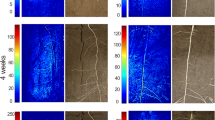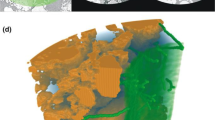Abstract
We compared modifications of soil zymography, a new in situ technique to visualize enzyme activities, based on contact of fluorgenic substrate-saturated membranes with soil either through the gel layer (gel zymography) or without gel application (direct zymography). We coupled zymography with quantitative measurements of enzyme kinetics to characterize catalytic mechanisms of β-glucosidase activity at the plant-soil interface including root surface (rhizoplane), rhizosphere, and bulk soil. Direct zymography refined and focused image resolution. The area of hotspots (i.e., spots with most intensive enzyme activity) as well as color intensity ratios estimated using direct zymography exceeded by a factor of 2 the corresponding values obtained with gel zymography. As determined by direct zymography, the percentage of hotspots associated to root surfaces was 58–68 % of total hotspot area. Hotspot area comprised only 6.8 ± 0.1 % of the total area of an image and 9.0 ± 3 % of the root surface area. The intensity of β-glucosidase activity, however, was up to 20 times higher in the hotspots versus bulk soil. The contribution of rhizosphere to β-glucosidase activity of the whole image (77–82 %) was four times higher than the contribution of the root surface. Enzyme kinetic parameters indicated different enzyme systems in bulk and rhizosphere soil. Higher substrate affinity and catalytic efficiency in bulk than in rhizosphere soil suggested relative domination of microorganisms with more efficient enzyme systems in the former. Coupling direct zymography and kinetic assays enabled mapping the two-dimensional (2D) distribution of enzyme activity at the root-soil interface and estimating the catalytic properties of root-associated and soil-associated enzymes.






Similar content being viewed by others
References
Badalucco L, Nannipieri P (2007) Nutrient transformations in the rhizosphere. In: Pinton R, Varanini Z, Nannipieri P (eds) The rhizosphere biochemistry and organic substances at the soil-plant interface. CRC Press, Boca Raton, pp 111–133
Bais HP, Park SW, Weir TL, Callaway RM, Vivanco JM (2004) How plants communicate using the underground information superhighway. Trends Plant Sci 9:26–32
Blagodatskaya Е, Kuzyakov Y (2008) Mechanisms of real and apparent priming effects and their dependence on soil microbial biomass and community structure: critical review. Biol Fertil Soils 45:115–131
Brimecombe MJ, De Leij FA, Lynch JM (2000) The effect of root exudates on rhizosphere microbial populations. Biochemistry and organic substances at the soil-plant interface. The rhizosphere, biochemistry and organic substances at the soil-plant interface. Marcel Dekker, Inc pp. 95–140
Button D (1991) Biochemical basis for whole-cell uptake kinetics: specific affinity, oligotrophic capacity, and the meaning of the Michaelis constant. Appl Environ Microb 57:2033–2038
Gianfreda L, Bollag JM (1994) Effect of soils on the behavior of immobilized enzymes. Soil Sci Soc Am J 58:1672–1681
Hinsinger P, Bengough AG, Vetterlein D, Young IM (2009) Rhizosphere: biophysics, biogeochemistry and ecological relevance. Plant Soil 321:117–152
Högberg P, Read DJ (2006) Towards a more plant physiological perspective on soil ecology. Trends Ecol Evol 21:548–554
Hoppe HG (1983) Significance of exoenzymatic activities in the ecology of brackish water-measurements by means of methylumbelliferyl-substrates. Mar Ecol-Prog Ser 11:299–308
Joner EJ, Van Aarle IM, Vosatka M (2000) Phosphatase activity of extra-radical arbuscular mycorrhizal hyphae: a review. Plant Soil 226:199–210
Kang H, Freeman C (2007) Interactions of marsh orchid (Dactylorhiza spp.) and soil microorganisms in relation to extracellular enzyme activities in a peat soil. Pedosphere 17:681–687
Kramer S, Marhan S, Ruess L, Armbruster W, Butenschoen O, Haslwimmer H, Kuzyakov Y, Pausch J, Scheunemann N, Schoene J (2012) Carbon flow into microbial and fungal biomass as a basis for the belowground food web of agroecosystems. Pedobiologia 55:111–119
Kuzyakov Y, Biryukova O, Kuznetzova T, Mölter K, Kandeler E, Stahr K (2002) Carbon partitioning in plant and soil, carbon dioxide fluxes and enzyme activities as affected by cutting ryegrass. Biol Fertil Soils 35:348–358
Ladd JN, Foster RC, Nannipieri P, Oades JM (1996) Soil structure and biological activity. In: Stotzky G, Bollag J-M (eds) Soil biochemistry vol 9. Marcell Dekker, New York, pp 23–78
Ling N, Sun Y, Ma J, Guo J, Zhu P, Peng C, Yu G, Ran W, Guo S, Shen Q (2014) Response of the bacterial diversity and soil enzyme activity in particle-size fractions of Mollisol after different fertilization in a long-term experiment. Biol Fertil Soils 50:901–911
Makboul HE, Ottow JCG (1979) Michaelis constant (K m) of acid phospatase as affected by montmorillonite, illite, and kaolinite clay minerals. Microb Ecol 5:207–213
Marinari S, Moscatelli C, Grego S (2014) Enzymes at plant-soil interface. In: Gianfreda L, Rao MA (eds) Enzymes in agricultural sciences, 1st edn. OMICS Group eBooks, Foster City, pp 94–109
Nannipieri P, Gianfreda L (1998) Kinetics of enzyme reactions in soil environments. In: Huang PM, Senesi N, Buffle J (eds) Structure and surface reactions. John Wiley & Sons, New York, pp 449–479
Nannipieri P, Ceccanti B, Cervelli S, Conti C (1982) Hydrolases extracted from soil: kinetic parameters of several enzymes catalysing the same reaction. Soil Biol Biochem 14:429–432
Nannipieri P, Ceccanti B, Bianchi D (1988) Characterization of humus-phosphatase complexes extracted from soil. Soil Biol Biochem 20:683–691
Nannipieri P, Sequi P, Fusi P (1996) Humus and enzyme activity. In: Piccolo A (ed) Humic substances in terrestrial ecosystems. Elsevier, Amsterdam, pp 293–328
Nannipieri P, Giagnoni L, Renella G, Puglisi E, Ceccanti B, Masciandaro G, Fornasier F, Moscatelli MC, Marinari S (2012) Soil enzymology: classical and molecular approaches. Biol Fertil Soils 48:743–762
Ortiz Jaramillo B, Kumcu A, Platisa L, Philips W (2015) Computing contrast ratio in images using local content information. In: Posada LG, Guarín PV (eds) 20th symposium on signal processing. Images and Computer Vision, Bogotá, pp 1–6
Palacios O, Bashan Y, de Bashan L (2014) Proven and potential involvement of vitamins in interactions of plants with plant growth-promoting bacteria—an overview. Biol Fertil Soils 50:415–432. doi:10.1007/s00374-013-0894-3
Panikov NS (1995) Microbial growth kinetics. Springer Science & Business Media, Netherlands
Pathan SI, Ceccherini MT, Hansen MA, Giagnoni L, Ascher J, Arenella M, Sørensen SJ, Pietramellara G, Nannipieri P, Renella G (2015) Maize lines with different nitrogen use efficiency select bacterial communities with different β-glucosidase-encoding genes and glucosidase activity in the rhizosphere. Biol Fertil Soils 51:995–1004
Pausch J, Kuzyakov Y (2012) Soil organic carbon decomposition from recently added and older sources estimated by δ 13C values of CO2 and organic matter. Soil Biol Biochem 55:40–47
Pii Y, Mimmo T, Tomasi N, Terzano R, Cesco S, Crecchio C (2015) Microbial interactions in the rhizosphere: beneficial influences of plant growth-promoting rhizobacteria on nutrient acquisition process. A review. Biol Fertil Soils 51:403–415
Pritsch K, Raidl S, Marksteiner E, Blaschke H, Agerer R, Schloter M, Hartmann A (2004) A rapid and highly sensitive method for measuring enzyme activities in single mycorrhizal tips using 4-methylumbelliferone-labelled fluorogenic substrates in a microplate system. J Microbiol Methods 58:233–241
Rao MA, Violante A, Gianfreda L (2000) Interaction of acid phosphatase with clays, organic molecules and organo-mineral complexes: kinetics and stability. Soil Biol Biochem 32:1007–1014
Sanaullah M, Blagodatskaya E, Chabbi A, Rumpel C, Kuzyakov Y (2011) Drought effects on microbial biomass and enzyme activities in the rhizosphere of grasses depend on plant community composition. Appl Soil Ecol 48:38–44
Spohn M, Kuzyakov Y (2013) Distribution of microbial-and root-derived phosphatase activities in the rhizosphere depending on P availability and C allocation–Coupling soil zymography with 14C imaging. Soil Biol Biochem 67:106–113
Spohn M, Kuzyakov Y (2014) Spatial and temporal dynamics of hotspots of enzyme activity in soil as affected by living and dead roots—a soil zymography analysis. Plant Soil 379:67–77
Spohn M, Carminati A, Kuzyakov Y (2013) Soil zymography—a novel in situ method for mapping distribution of enzyme activity in soil. Soil Biol Biochem 58:275–280
Tischer A, Blagodatskaya E, Hamer U (2015) Microbial community structure and resource availability drive the catalytic efficiency of soil enzymes under land-use change conditions. Soil Biol Biochem 89:226–237
Treseder KK, Vitousek PM (2001) Effects of soil nutrient availability on investment in acquisition of N and P in Hawaiian rain forests. Ecology 82:946–954
Uksa M, Schloter M, Kautz T, Athmann M, Köpke U, Fischer D (2015) Spatial variability of hydrolytic and oxidative potential enzyme activities in different subsoil compartments. Biol Fert Soils 51:517–521
Valentinuzzi F, Cesco S, Tomasi N, Mimmo T (2015) Influence of different trap solutions on the determination of root exudates in Lupinus albus L. Biol Fert Soils 51:757–765
Vandooren J, Geurts N, Martens E, Van den Steen PE, Opdenakker G (2013) Zymography methods for visualizing hydrolytic enzymes. Nat Methods 10:211–220
Waldrop MP, Balser TC, Firestone MK (2000) Linking microbial community composition to function in a tropical soil. Soil Biol Biochem 32:1837–1846
Wallenstein MD, Weintraub MN (2008) Emerging tools for measuring and modeling the in situ activity of soil extracellular enzymes. Soil Biol Biochem 40:2098–2106
Whipps JM (2001) Microbial interactions and biocontrol in the rhizosphere. J Exp Bot 52:487–511
Zhang Y, Sun CX, Chen L, Duan Z (2009) Catalytic potential of soil hydrolases in northeast China under different soil moisture conditions. Rev Cienc Suelo Nutr 9:116–124
Acknowledgments
We acknowledge the Alexander von Humboldt Foundation for financial support of MS and the DAAD for BSR. The contribution of EB was supported by the Russian Scientific Foundation (project No. 14-14-00625). This study was supported by the German Research Foundation (DFG) within the Research Unit “Carbon flux through the soil animal food web” (FOR 918; KU1184/3-2). We highly acknowledge the guidance and input of the editor and the reviewers for the improvement of this manuscript.
Author information
Authors and Affiliations
Corresponding authors
Rights and permissions
About this article
Cite this article
Sanaullah, M., Razavi, B.S., Blagodatskaya, E. et al. Spatial distribution and catalytic mechanisms of β-glucosidase activity at the root-soil interface. Biol Fertil Soils 52, 505–514 (2016). https://doi.org/10.1007/s00374-016-1094-8
Received:
Revised:
Accepted:
Published:
Issue Date:
DOI: https://doi.org/10.1007/s00374-016-1094-8




